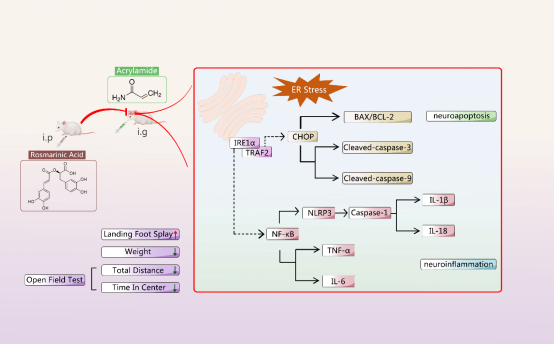GXU Prof. Zhong-Quan Qi 's Team Revealed New Mechanisms by which Rosmarinic Acid Reverses the Neurotoxicity of Acrylamide
On February 12th, 2024, the team led by Professor Zhong-Quan Qi from the Medical College of Guangxi University published a paper titled “Rosmarinic acid mitigates acrylamide induced neurotoxicity via suppressing endoplasmic reticulum stress and inflammation in mouse hippocampus.” in the journal Phytomedicine. The paper reveals a new mechanism by which rosmarinic acid reverses acrylamide induced neurotoxicity from the perspectives of inflammation and endoplasmic reticulum stress.
Acrylamide is a water-soluble vinyl monomer that is widely used in various industrial sectors, including the production of cosmetics, textiles, the paper industry, and wastewater treatment. Additionally, in daily life, people may be exposed to residual acrylamide through multiple pathways, such as cosmetics, packaging materials, and water treated with polyacrylamide flocculants. Research indicates that the toxicity of acrylamide primarily includes neurotoxicity, reproductive toxicity, and potential carcinogenicity, with neurotoxicity having been confirmed through human and animal experiments. Epidemiological studies have linked acrylamide exposure to an increased risk of mild cognitive decline and impairment in middle-aged and elderly men. Animal experiments have shown that repeated exposure to acrylamide induces neurotoxic symptoms in experimental animals, mirroring those observed in humans.
In this study, researchers attempted to reverse the neurotoxicity induced by acrylamide in mice using rosmarinic acid, a natural polyphenol derivative extracted from plants of the Perilla genus. Firstly, through landing foot splay and open field tests, a general assessment of the mice’s neurofunction was conducted. The results showed that, compared to the control group, the acrylamide group had increased landing foot splay distance, which was reversed by rosmarinic acid treatment. Through the open field test, it was found that the total movement distance of mice in the acrylamide group was significantly reduced, and the time spent in the center of the open field was also greatly reduced. Compared to the acrylamide group, rosmarinic acid treatment reversed the reduction in total movement distance in mice and increased the time spent in the center of the open field.
Histological studies revealed that after exposure to acrylamide, the number of hippocampal neurons in mice significantly decreased, with cell nuclei condensing and the boundary between the cell membrane and nucleus becoming blurred. Compared to the acrylamide exposure group, the rosmarinic acid intervention group had fewer morphological necrosis of neurons and fewer pathological changes.
Mechanistic studies showed that acrylamide exposure could promote the accumulation of inflammation in hippocampal tissue, manifested by increased expression of IL-6 and TNF-α and activation of the NF-κB pathway. At the same time, key proteins in the NLRP3 pathway, including NLRP3, Caspase-1, IL-1β, and IL-18, were upregulated in the hippocampal tissue of acrylamide-exposed mice, while rosmarinic acid could rescue hippocampal neuroinflammation induced by ACR by inhibiting the activation of the NLRP3 inflammatory pathway. Additionally, rosmarinic acid could reverse the ER stress induced by acrylamide in hippocampal neurons, with P-IRE1α, BIP, CHOP, and TRAF2 protein expression more closely resembling that of normal mice. These findings comprehensively reveal the molecular mechanism of rosmarinic acid reversing acrylamide neurotoxicity.
Tian-Bao Wang from the Medical College of Guangxi University is the first author of the paper, and Zhong-Quan Qi and Yu Liu are the corresponding authors of the paper. This research was supported by the National Natural Science Foundation of China (Grant No. 32200698 and 81971505 ).
